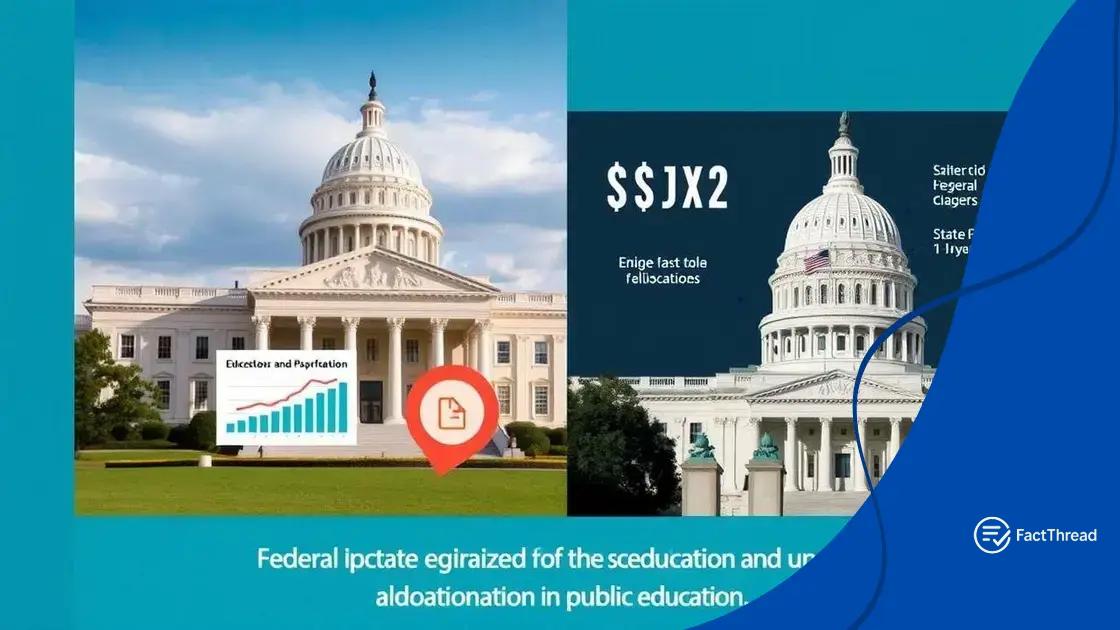Funding for public schools remains a contentious issue

Funding for public schools significantly impacts educational outcomes, with equitable funding ensuring all students have access to necessary resources, qualified teachers, and better learning environments.
Funding for public schools remains a contentious issue that many parents and educators grapple with daily. Have you ever considered how these financial debates affect your community’s schools? Let’s dive into the intricacies of school funding.
The historical context of school funding
Understanding the historical context of school funding is essential to grasp why current debates are so heated. Over the years, funding sources for public schools have evolved dramatically, influenced by laws, policies, and societal changes.
In the early 20th century, most school financing came from local property taxes. This approach meant that wealthier neighborhoods had more resources while poorer areas faced deficits. As this disparity grew, states began to implement reforms to create a more equitable funding system.
The 1971 Supreme Court Case
A pivotal moment in educational funding was the 1971 Supreme Court case, Rodriguez v. San Antonio Independent School District. This case questioned the legality of using property taxes as the primary funding source. Although the court ruled against the plaintiffs, it highlighted the inequities in the system.
Changes in Legislation
In response to ongoing disparities, federal legislation like the Elementary and Secondary Education Act (ESEA) of 1965 aimed to supplement funding in low-income areas. This law was a significant step toward addressing inequity and ensuring that all children had access to quality education.
- Local funding primarily based on property taxes
- Pivotal court cases revealing inequities
- Federal legislation aimed at supporting low-income students
Despite these efforts, challenges remain. Many schools still depend heavily on local funding, perpetuating the cycle of inequality. Recent discussions about education reform often circle back to the effectiveness of our current funding models.
As we look at the historical evolution of school funding, it becomes clear that understanding the past helps us navigate the future. The impact of funding on educational opportunities cannot be underestimated, and this history is essential for shaping ongoing discussions surrounding public school financing.
Key challenges facing public school funding
Public school funding faces many key challenges that complicate the educational landscape. These obstacles often hinder efforts to provide quality education for all students.
One significant challenge is the reliance on local property taxes for funding. This method creates disparities between wealthy and low-income districts, leading to unequal resources and opportunities. Schools in affluent areas generally have better facilities and more experienced teachers, while schools in poorer regions struggle to meet basic needs.
Funding Inequities
Understanding the impact of funding inequities is crucial. Students in low-income areas often lack access to advanced courses, extracurricular activities, and essential learning materials. These limitations can affect their academic performance and future prospects.
Legislative Changes
Another challenge is the constant shift in education policy. Changes in state and federal funding formulas can create instability, leading to uncertainty for school administrators and educators. When funding is cut or reallocated, it can result in layoffs, larger class sizes, and reduced programs.
- Over-reliance on local property taxes
- Disparities in educational resources
- Frequent changes in legislative policies
- Uncertainty affecting school operations
The evolving landscape of public school funding can also challenge community support. Residents may feel disconnected from the education system, especially if they believe their contributions do not lead to improved outcomes. Strengthening ties between schools and communities is essential for fostering support and advocacy for equitable funding.
Addressing these key challenges requires collaboration among stakeholders, including educators, policymakers, and community members. By working together, we can strive to create a more equitable funding system that benefits all public school students.
The role of federal and state funding

The role of federal and state funding in public education is crucial for maintaining and improving school systems. These funding sources help bridge the financial gaps that many districts face, especially those in low-income areas.
Federal funding generally aims to support specific initiatives, such as special education, low-income schools, and nutrition programs. One of the key sources of federal funding is the Title I program, which focuses on improving educational outcomes for children from disadvantaged backgrounds. By channeling resources to these schools, federal aid promotes equity in education.
State Funding Mechanisms
State funding plays a significant role in determining how much money schools receive. Different states have various funding formulas, which often consider factors like student enrollment and local needs. Some states allocate funds based on average daily attendance or property values, while others use weighted formulas that account for socioeconomic factors.
Challenges of Federal and State Funding
However, both federal and state funding systems face challenges. For instance, federal contributions can fluctuate based on political priorities and budget constraints, leading to inconsistencies in available resources over time. Similarly, state budget cuts can have dire consequences for schools, leading to larger class sizes and fewer resources.
- Federal programs like Title I target low-income students
- State funding formulas vary significantly
- Funding can be inconsistent due to budget constraints
- Political climate impacts education funding
Ultimately, the effectiveness of federal and state funding hinges on collaboration between government entities and school districts. Continuous evaluation of funding mechanisms is necessary to ensure equitable opportunities for all students.
Impact of funding on educational outcomes
The impact of funding on educational outcomes is significant and multifaceted. Schools that receive adequate funding are more likely to provide better educational resources, hire qualified staff, and create enriching learning environments.
Research shows a direct correlation between funding levels and student performance. Schools with higher funding can afford modern technology, updated textbooks, and supportive programs like counseling. This support is vital for fostering student success and engagement.
Effects on Classroom Resources
One immediate effect of increased funding is the availability of essential classroom resources. Students who have access to the latest learning materials and tools can better engage with the curriculum. Additionally, adequate funding allows for smaller class sizes, enabling teachers to give more individual attention to students.
Teacher Recruitment and Retention
Funding also plays a crucial role in attracting and retaining quality educators. When schools can offer competitive salaries and benefits, they are more likely to hire experienced and effective teachers. Research indicates that well-trained teachers have a profound impact on student learning. Conversely, schools struggling with limited resources often face high turnover rates and a lack of qualified instructors.
- Better resources lead to improved student engagement
- Smaller class sizes allow for personalized instruction
- Competitive salaries attract skilled teachers
- Quality educators contribute to enhanced learning outcomes
In conclusion, the relationship between educational funding and outcomes highlights the need for consistent investment in public schools. For students to achieve their full potential, equitable funding must be a priority for educators and policymakers alike.
Future trends in school financing
Understanding the future trends in school financing is crucial for educators, parents, and policymakers. As the demands of education evolve, so do the funding strategies to meet those needs.
One major trend is the increasing focus on transparency and accountability in school funding. Many states are moving towards more detailed public reporting on how funds are allocated and spent. This shift aims to ensure that resources reach the students and programs that need them most.
Equity in Funding
Another trend gaining momentum is the push for equitable funding models. As awareness of funding disparities grows, many advocates are calling for reforms that ensure all schools receive adequate support, regardless of their location or the wealth of their surrounding community. These equitable models often incorporate factors such as students’ socioeconomic status and specific educational needs.
Technology and Innovation
Technology also plays a vital role in shaping the future of school financing. With the rise of digital tools and online platforms, many school districts are finding innovative ways to manage their budgets and track spending. For instance, some districts utilize software to analyze where funds are spent and identify areas for improvement, helping to optimize existing resources.
- Increased focus on transparency and accountability
- Efforts toward equitable funding models
- Integration of technology in budget management
- Emerging partnerships with private organizations
A growing trend involves forming partnerships with private organizations and non-profits to supplement school funding. These collaborations can bring additional resources and innovative ideas into the education system, ultimately benefiting students.
FAQ – Frequently Asked Questions about Public School Funding
What is the impact of funding on educational outcomes?
Funding significantly affects school resources, teacher quality, and student engagement, leading to better educational results.
How does federal funding support public schools?
Federal funding, through programs like Title I, aims to assist schools serving low-income students, enhancing educational opportunities.
What are the key challenges faced in school funding?
Main challenges include reliance on local property taxes, funding disparities, and fluctuating state budgets.
What future trends are shaping school financing?
Future trends include increased transparency, equitable funding models, and the integration of technology in budget management.